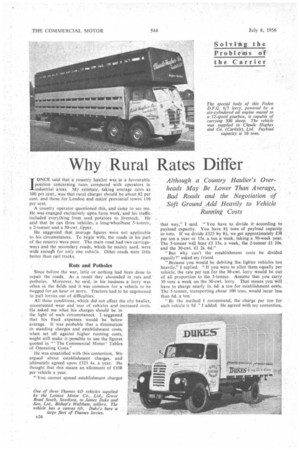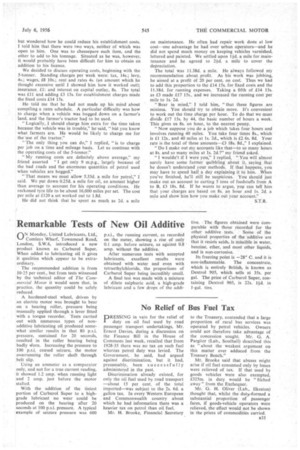Why Rural Rates Differ
Page 72

Page 79

If you've noticed an error in this article please click here to report it so we can fix it.
Although a Country Haulier's Overheads May Be Lower Than Average,• Bad Roads and the Negotiation of Soft Ground .,Add Heavily to Vehicle
Runhing Costs
I ONCE said that a country haulier. was in a favourable position concerning, rates compared with operators in
. industrial areas. My estimate, taking average rates as . 100 per cent., was that rural charges should be about 82 per cent, and those for London and major provincial towns 110 per cent. . . . , A country operator questioned this, and came to see me.
• He was engagedexclusively upon, farni Work, and his traffic included everything from seed potatoes to livestock. He said that he ran three vehicles, a long-wheelbase 5-tonner, a 2-tanner and a 30-cwt. :tipper. . . He suggested that average figures were not applicable to his circumstances— To begin with, the roads in his part of the country were poor. The main road had two carriageways and the secondary roads, which he mainly used, were wide enough for only one vehicle. Other roads were little _ better than cart tracks.
Ruts and Potholes
Since before the war, little or nothing had been done to repair the roads. As a result they abounded in ruts and potholes. Moreover, he said, in his business a lorry was often in the fields and it was common for a vehicle to be bogged for an hour or more. Tractors had to be summoned to pull lorries out of difficulties.
All these conditions, which did not affect the city haulier, accentuated wear and tear of vehicles and increased costs. He asked me what his charges should be in , the light of such circumstances. I suggested that his fixed expenses would be below average. It was probable that a diminution in standing charges and establishment costs, when set off against higher running costs, might still make it possible to use the figures quoted in " ' The Commercial Motor' Tables of Operating Costs."
He was unsatisfied with this contention. We argued about establishment charges, and ultimately agreed upon £323 4s. a year. He thought that this meant an allotment of £108 per vehicle a year.
" You cannot spread establishment charges
that way," I said. "You have to divide itaccording to payload capacity. You have 81 tons of payload capacity in toto. If we divide £323 by 84-, we get approximately £38 per ton a year or 15s. a ton a week, taking a 50-week year. The 5-tonner will bear £3 15s. a week, the 2-tonner £1 10s, and the 30-cwt. £1 2s. bd."
"Hut why can't the establishment costs be divided equally?" asked my friend, "Because you would be debiting the lighter vehicles too heavily," I replied. " If you were to allot them equally per vehicle, the rate per ton for the 30-cwt, lorry would be out of all proportion to the 5-tonner. Assume that you carry 30 tons a week on the 30-cwt. lorry. That means you will have to charge nearly Is. bd. a ton for establishment costs. The 5-tonner, transporting about 100 tons, would incur less than 6d. a ton.
" By the method I recommend, the charge per ton for each vehicle is 9d ." I added. He agreed with my contention, but wondered how he could reduce his establishment costs. I told him that there were two ways, neither of which was open to him. One was to cheesepare each item, and the other to add to his tonnage. Situated as he was, however, it would probably have been difficult for him to obtain an addition to his licence.
We decided to discuss operating costs, beginning with the 5-tonner. Standing charges per week were: tax, I4s.; levy, 4s.; wages, £8 10s.; rent and rates 4s. (an amount which he thought excessive until 1 showed him how it worked out); insurance, £1; and interest on capital outlay, 8s. The total was £11 and adding £3 15s. for establishment charges made the fixed costs £14 15s.
He told me that he had not made up his mind about compiling a rates schedule. A particular difficulty was how to charge when a vehicle was bogged down on a farmer's land, and the farmer's tractor had to be used.
" Logically, I should charge him extra for the time taken because the vehicle was in trouble," he said, "but you know what farmers are. He would be likely to charge me for the use of the tractor."
"The only thing you can do," I replied, "is to charge per job on a time and mileage basis. Let us continue with the operating costs of the 5-tonner."
"My running costs are definitely above average," my friend asserted "1 get only 9 m.p.g., largely because of the bad roads and the enormous quantities of petrol used when vehicles are bogged."
"That means we must allow 5.33d. a mile for petrol," I said. We put down 0.25d. a mile for oil, an amount higher than average to account for his operating conditions. He reckoned tyre life to be about 16,000 miles per set. The cost per mile at £120 a set worked out to I.8d.
He did not think that he spent as much as 2d. a mile on maintenance. He often had repair work done at low cost--one advantage he had over urban operators-and he did not spend much money on keeping vehicles varnished, lettered and painted. We settled upon lid. a mile for maintenance and he agreed to 21d. a mile to cover the depreciation.
The total was 11.38d. a mile. He always followed my recommendation about profit. As his work was jobbing, he aimed at a profit of 20 per cent. on cost. Thus we had to add this proportion to the £14 15s. for fixed costs and the 11.38d. for running expenses. Taking a fifth of £14 15s. as £3 made £17 15s., and we increased the running cost per mile to Is. 2d.
"Bear in mind," I told him, "that these figures are minima. You should try to obtain more. It's convenient to work out the time charge per hour. To do that we must divide £117 I5s. by 44, the basic number of hours a week. This gives us 8s. an hour, to the nearest penny.
"Now suppose you do a job which takes four hours and involves running 40 miles. You take four times 8s., which is £1 12s., and 40 miles at Is. 2d., which is £2 6s. 8d. Your rate is the total of these amounts-£3 18s. 8d.," I explained.
"Do I make out my accounts like that-to so many hours at 8s. and so many miles at Is. 2d.?" my friend asked.
"I wouldn't if I were you," I replied, "You will almost surely have some farmer quibbling about it. saying that he doesn't understand your methods. If that happens, you may have to spend half a day explaining it to him. When you've finished, he'll still be suspicious. You should just make out an account to carting 5 tons of feedstuffs from A to B, £3 I8s. 8d. If he wants to argue, you can tell him that your charges are based on 8s. an hour and Is. 2d. a mile and show him how you make out your account."
























































































































